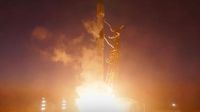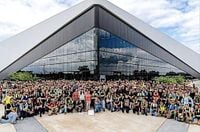On the evening of Monday, June 16, 2025, SpaceX once again lit up the Southern California skies with the launch of its Falcon 9 rocket, carrying 26 Starlink satellites into low Earth orbit. The rocket lifted off precisely at 8:36 p.m. Pacific Time from Space Launch Complex 4 East at Vandenberg Space Force Base in Santa Barbara County, marking the 31st launch from the base this year.
The Falcon 9 rocket used for this mission was making its third flight, demonstrating SpaceX's commitment to reusability and cost-efficiency in space travel. After the rocket's first stage separated approximately eight minutes after liftoff, it successfully landed on the "Of Course I Still Love You" droneship stationed in the Pacific Ocean, ready for potential reuse in future missions.
SpaceX’s Starlink constellation, described as the world’s first and largest satellite network using low Earth orbit to deliver broadband internet, continues to expand with this launch. The 26 satellites, part of Group 15-9, reached orbit about eight and a half minutes after liftoff and were scheduled for deployment following a second burn of the Falcon 9’s upper stage roughly one hour into the mission.
Starlink satellites orbit Earth at an altitude of approximately 550 kilometers (around 342 miles), providing high-speed, low-latency internet access capable of supporting streaming, online gaming, video calls, and more. Users connect to the network through antennas installed at their homes, enabling internet connectivity in remote and underserved areas worldwide.
This latest batch of satellites adds to the more than 7,760 active Starlink units currently in orbit, reinforcing SpaceX’s goal to blanket the globe with reliable broadband service. The mission follows a recent Starlink deployment from Florida’s Cape Canaveral Space Force Station on June 13, which completed the company’s first-generation direct-to-cell constellation. That milestone enables unmodified cellphones to connect directly to Starlink satellites in remote regions, a groundbreaking step in global connectivity.
Residents across Southern California, including Santa Barbara, San Luis Obispo, and Ventura counties, were reminded by SpaceX that they might hear sonic booms during the launch, depending on weather and other conditions. Such booms and visible vapor trails have become familiar sights and sounds in the region, with a notable sonic boom and rattling reported in May 2025 due to a SpaceX cargo vessel.
The launch window on Monday extended from 8:36 p.m. to 9:07 p.m. Pacific Time, with a backup opportunity scheduled for Tuesday, June 17, starting at 5:37 p.m. PT, in case of any delays. However, the mission proceeded successfully on the first attempt, adding another chapter to SpaceX’s rapid cadence of launches and satellite deployments.
Falcon 9, SpaceX’s reusable two-stage rocket, is celebrated as the world’s first orbital-class reusable rocket. Designed and manufactured by SpaceX, it reliably transports people and payloads into Earth orbit and beyond. The booster used in this mission, serial number B1093, previously flew in May 2025 on its second Starlink flight, underscoring the company’s focus on sustainability and cost reduction in spaceflight.
SpaceX’s Starlink project aims to bridge the digital divide by delivering broadband internet to areas where traditional infrastructure is lacking or unreliable. The constellation’s low Earth orbit positioning allows for high-speed connections with minimal latency, a significant advantage over traditional satellite internet services that operate much farther from Earth.
The success of this launch also highlights the strategic importance of Vandenberg Space Force Base, which has hosted 31 launches so far in 2025. Located on the Southern California coast, it provides an ideal site for missions requiring polar and sun-synchronous orbits, such as those used by Starlink satellites.
Robert Pearlman, a noted space historian and journalist, remarked on the significance of these deployments, noting how Starlink continues to evolve and expand its capabilities. "Working with cellular providers around the world, direct to cell enables unmodified cellphones to have connectivity in the most remote areas," he explained, referencing the recent milestone achieved by SpaceX.
SpaceX’s growing Starlink network represents a transformative shift in global internet access, with the company steadily increasing the number of active satellites and enhancing service quality. The June 16 launch is a testament to this progress, demonstrating the company’s ability to conduct rapid, reliable launches while maintaining the reusability of its Falcon 9 boosters.
As the Starlink constellation grows, so does the potential for connecting underserved populations, improving emergency communications, and supporting new technologies that rely on fast and stable internet connections. SpaceX’s ambitious vision continues to take shape, one launch at a time, lighting up the night sky and the digital landscape simultaneously.



